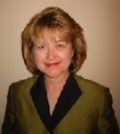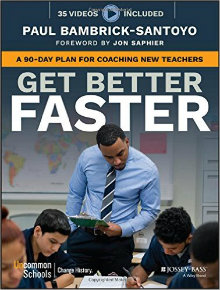A 90-Day Plan for Coaching New Teachers
Get Better Faster: A 90-Day Plan for Coaching New Teachers
By Paul Bambrick-Santoyo
(Jossey-Bass, 2016; Uncommon Schools [videos], 2016 – Learn more)

It’s no secret. Beginning teachers have a tough time. And now, when some states are having a teacher shortage, they come into the school environment with even less experience and training.
So, although this is a thick book and may seem intimidating, it is a comfort to know that it doesn’t have to be used as a program, but can be read and accessed as necessary by the mentor, coach or administrator.

Demolishing myths
Paul Bambrick-Santoyo smashes some common myths about teaching such as “Practice Doesn’t Make Perfect – Experience Does.” This is why the author wants “in-the-moment,” early guidance for teachers.
Another myth is that behavior management needs to be handled first before learning can take place. We can’t afford to wait for management to be flawless, and in fact, good lesson planning and routines and procedures will prevent many problems.
Because I have worked extensively with beginning teachers at both high and low-performing schools, I saw that the more successful ones came into the system knowing the Madeline Hunter model of teaching. So I was disappointed that the author gave no acknowledgement to this giant of education or other educational pioneers.
Hunter’s seven-step lesson plan allowed us to think in terms of the components of a good lesson, and she named techniques like “proximity” and “checking for understanding” so that once we heard them, we knew why we used some strategies, even if they were intuitive.
Helpful resources
There is much of value in this book, and some of the checklists and charts alone (plus the videoclips, available on a separate disk in the back of the book and online) are worth the price of the book. Also, the idea that we can’t afford to wait and let a teacher stumble through an entire year and fix mistakes by trial and error is an important one because of effects on students.
This book wants to go beyond classroom management to include classroom dialogue, good objectives and more, with 90 days of expert coaching at the beginning of the year. Succeeding early is “a matter of immense urgency.” Included are personal stories of success using this side-by-side coaching method. Bambrick-Santoyo is the chief schools officer for high schools and K-12 content development at Uncommon Schools and has had much success and recognition for this coaching model.
There is a Scope and Sequence chart at the beginning of the book that tells the top action steps to launch teacher development. They include developing “Essential Routines and Procedures.” The author addresses some issues that are rarely mentioned in teacher training, possibly because some believe they are too personal. For example, Bambrick-Santoyo talks about posture, standing still, tone, and word choice.
The challenge of timing for Phase 1
Bambrick-Santoyo would like Phase 1, out of 4 phases, to begin in the summer before school starts – a “dress rehearsal.” This means the coaches and trainers would have to be trained even before this time or at least have read and considered the separate chapter on “Principles of Coaching” and the case studies. Given beginning teachers with families and union contract constraints, I don’t know how this would work in many districts. My dream is that all this be done in student teaching.
The author argues that 75% of leaders agree “Success or failure during the first few months is a strong predictor of overall success or failure in the job.” Finding personnel, however, either paid or volunteer, for all the coaching phases is another constraint that will have to be worked out, if possible. So, realistically, much of the work of this book in most places will need to be done by a single administrator or two.
Coaching in Phases 2 through 4
Phase 2, according to the plan, would begin on day one of school and continue for 30 days, when routines and procedures would be revised and perfected. This phase includes how to monitor student work and how to “reset” a whole class. I like that there are phrases for the teacher to use, such as “Pencils down. Eyes on me.” When an entire school culture uses the same language, it can be very powerful for setting expectations.
Phase 3 ideally takes place during days 31-60. The coach will help the teacher engage the class and make sure everybody participates, concentrating on what students do well (“narrating the positive”). The coach will help the teacher respond to student needs and revise plans.
Phase 4, days 61-90, introduces small group work and re-teaching and “Habits of Discussion.”
Organizational challenges
At times I wished the book had been organized more simply or was less wordy. Perhaps it would have been easier to follow if it were divided into “elementary” and “secondary,” or subject areas, or in terms of the teacher having a common problem and here’s what to do about it. It also seems that school-wide practices might help rather than a focus on individual problems as they occur.
In one case study I saw the problem differently. I thought it could have been avoided had the teacher reviewed some key vocabulary terms. I also think teachers have to be careful about what are now called “exemplars.” If, say, an essay is far more sophisticated than most students can write, they will be intimidated and never get their own thoughts on paper. I would rather see the teacher write with students and show them that they too struggle and then revise and revise and revise. Coaches, I believe, should be subject-matter experts.
There needs to be more advice for the coach on how to intervene when necessary and not undermine the teacher. For example, perhaps the coach can ask the teacher aloud if the coach can demonstrate something learned from their own elementary or high school teacher that they never forgot and that has helped them.
This book too often seems overwhelming, and if used as the author desires, there would have to be buy-in from the top down and money to pay stipends for extra time for experienced teachers. However, there are some one-page “blueprints” and “Quick Reference Guides” and some tips and techniques on engaging students and pacing lessons that I would like to see in the hands of all coaches and teachers.
Developing teachers, not simply evaluating them
Teaching is a performance profession. Even the small things we say and do affect students. If a district cannot adopt this method or program of helping beginning teachers, then several should read it and share the valuable information that could make a difference. The book is a convincing argument for developing teachers rather than simply evaluating them.
Dr. Mary Langer Thompson’s articles, short stories, and poetry appear in various journals and anthologies. She has worked with hundreds of beginning teachers as a “Clinical Consultant” at UCLA, a Master Teacher, and as a public school administrator.
































